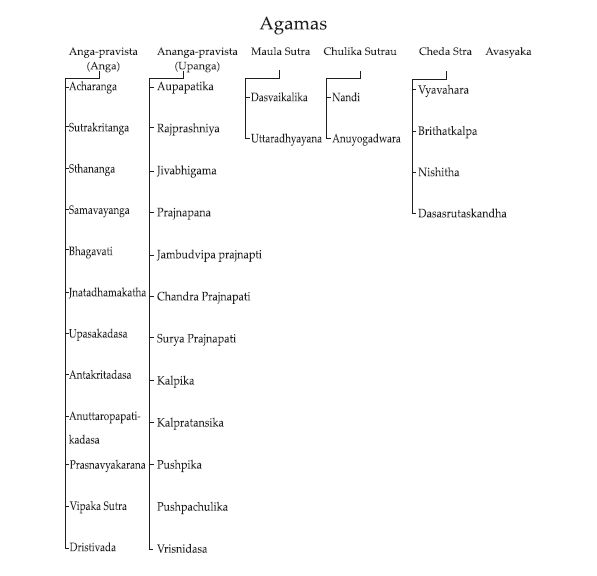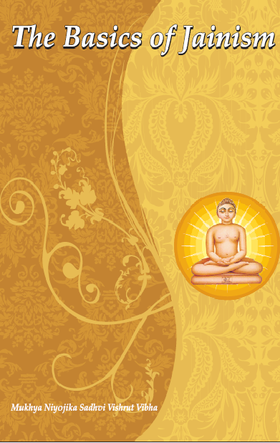
Table displaying the Jain Scriptures and their bifurcation.
The Jain scriptures are popularly known as' Agama'. Just as the 'Vedas' have an important place in Vedic tradition; the 'Tripitakas' in Buddhism; the 'Gurugranthasahib' in Sikkhism; the 'Torah' in Judaism and the 'Bible' in Christianity, similarly, the Agamas play a pivotal role in Jainism. They have been divided into six parts:
- Anga - pravista(anga)
- Ananga - pravista (upanga)
- Mulasutra
- ChulikaSutra
- Cheda sutra
- Avasyaka (which forms a part of the chedda sutra)
- Anga:
It is believed that, after attaining omniscience, all the knowledge Lord Mahavira delivered to his disciples was compiled by the 'Ganadharas' (chief disciples) in twelve Angas. They are collectively known as Dwadashangi or Ganipitaka. Thus, the twelve Angas are the oldest and original part of the canonical literature. The following is a brief description of each Anga:
- Acharanga - The Acharanga primarily deals with Jain ethics and the rules of conduct for ascetics. Lord Mahavira's life and philosophy is also narrated.
- Sutrakritanga - The Sutrakritanga discusses the weakness of some other philosophers due to their onesided outlook regarding reality, rites and rituals. It deals with the doctrines of different heretical sects.
- Sthanga - The sthanga deals with the classification of Jiva, matter and other objects from a numerical points of view. For example, in the first chapter we find the description of Jiva. In the second chapter, Jiva is classified in two categories. In the third one, it is categorised in three categories. The classification of Jiva continues in this way reaching up to ten. We refer to this as the numerical point of view.
- Samavayanga - It also deals with miscellaneous topics from the numerical point of view.
- Bhagavati (vyakhyapragyapti) - The Bhagavati is the most important Jain canon, dealing with 36000 questions asked by Gautama, the first Ganadhara, and answers given by Lord Mahavira.
- Gyatadharmakatha - The gyatadharmakatha contains stories and parables given by Lord Mahavir which expounds philosophical facts.
- Upasakadasa- The Upasakadasa elaborates the code of conduct for the householder. It gives the biographies of the ten principal shravakas (lay disciples) of Lord Mahavira.
- Antakritdasa_- The Antakritdasa narrates the biographies of many saints who attained salvation through austerities and penances.
- Anuttaropapatikadasa - The Anuttaropapatikadasa gives an account of those ascetics who were reborn in one of the five supreme heavens at the last moment of their life.
- Prasnavyakarana - The Prasnavyakarana deals with the ethical aspects of Jain philosophy especially the causes of the influx of karma and its inhibitions. It also recounts four types of narrative viz. Akshepani, Vikhshepani, Samvejini and Nirvejini.
- Vipaksutra - The Vipaksutra explains the bondage, operation and fruition of meritorious and unmeritorious karma.
- Dristivada - According to svetambara tradition dristivada is not available, it has been completely lost. Even though Dristivada has been long lost, the contents of this Agama have been referred to and explained in the Nandi and Samvayanga Sutras. By studying them, we come to the conclusion that Dristivada was a prominent and very vast sutra which contains purva. It was divided into five parts viz.
- Parikarma;
- Sutra;
- Purvanayoga;
- purvagata;
- Chulika.
The fourteen purvas were the constituents of the fourth part, the purvagata. This Dwadasangi (the above twelve canonical texts) occupies a prominent place in the Jain canonical literature. Its validity is inherent in its nature. The Jain agama are replete with exhaustive knowledge on almost all subjects. The fourth section of the twelth Anga, the Dristivada - which has been lost - is believed to contain the knowledge of fourteen purva viz. the (1) Utpad Purva; (2) Agrayaniya Purva; (3) Viryapravada Purva; (4) Asti Nasti Pravada Purva; (5) Jnana Pravada Purva; (6) Satya Pradvada Purva; (7) Atma Pravada Purva; (8) Karma Pravada Purva; (9) Pratyakhan Purva; (10) Vidya Pravada Purva; (11) Kalyana Pravada Purva; (12) Prana Pravada Purva; (13) Kriya Visal Purva; and (14) Lokbindusar Purva.
The contents of these works provide detailed information about six kinds of substances; all kinds of living organisms; the things that exist for eternity those which were to come into being for a transient time and their time of extinction; five kinds of knowledge; truth, soul, karma, mantra, the benefits of austerities; the lifestyles of ascetics and householders; birth, death and a detailed description of the whole universe. All the Agamas are written in Ardhamagadhi, which was the language of the time when Lord Mahavira lived.
- Upanga:
The Upanga are the sculpture composed by different Acharya. They are:
- Aupapatika:- The Aupapatika contains lectures of Lord Mahavira on the birth of twenty-two different types of souls in addition to a variety of other religious subjects.
- Raj prashniya:The Rajprashniya contains the dialogue between the Ascetic Keshi and king pradeshi.
- Jiva Bhigam:- The Jivabhigam contains lectures on the Jiva, ajiva and their classification.
- Pragyapana:- The Pragyapana describes Jain ontology and metaphysics.
- Jambudvipa-pragyapti:- The Jambudvipa-pragyapti provide the geographical description of Jambudvipa (i.e. accounts of rivers and mountains etc.)
- Chandra-Pragyapati:- The Chandra-Pragyapati contains the description of the moon.
- Surya-Pragyapati:- The Surya-pragyapati contains the description of the sun and other celestial bodies. The last five upangas are
- Kalpika,
- Kalpavatansika,
- Pushpika,
- Pushpachoolika,
- Vrshnidasa. These Upanga contains descriptions of heaven and hell, battles of king etc.
- MulaSutra:-
The Mula Sutra are two in number:
- Dasvekalika:- The Dasvekalika was compiled by Acharya Shayyambhava. It contains the code of conduct for the ascetics.
- Uttaradhyayan:- The Uttaradhyayan concerns various subjects such as leshya, karma, soul etc. and includes a number of fascinating stories.
- Chulika Sutra:
- Nandi:- Nandi is a scripture of Jain epistemology. It discusses nature and the types of knowledge.
- Anuyogadwara:- The Anuyogadwara is a compendium of Jain technical terms. In addition there are incidental references to Pramana (valid knowledge) and Naya (partial viewpoints) as well as other principles of Jain logic.
- Chedda Sutra:
The four Chedda sutra contain explanations and regulations of the ascetic life. They are:
- Vyavahar
- Brihatkalpa
- Nishitha
- Dasashrutaskandha
- Avasyaka sutra
